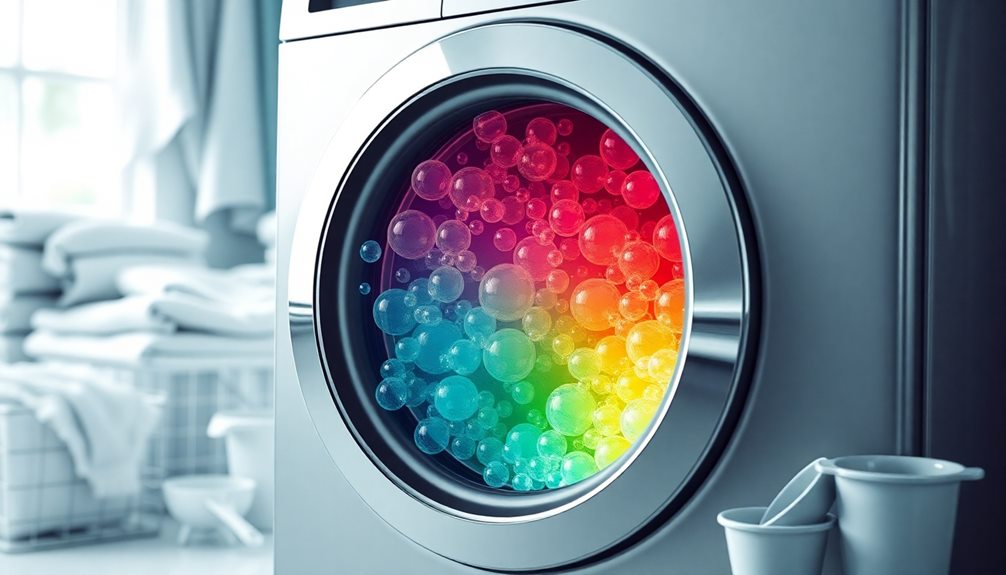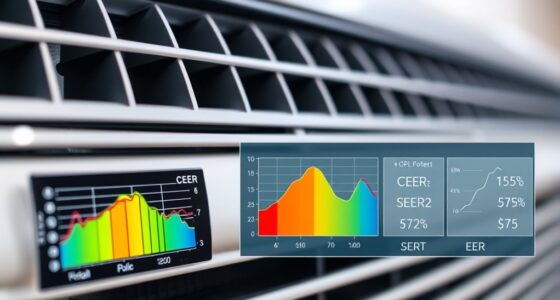The amount of soap you should use in your washing machine depends on the type of washer and the load size. For high-efficiency (HE) machines, use 1 to 2 tablespoons per load, while traditional top loaders need about 2 tablespoons. Smaller loads require less detergent—often under 1 tablespoon. If you have hard water, you might need up to 2 tablespoons. Always measure accurately with a cup, as using too much can lead to soap buildup and odors. Wondering how to adjust your usage based on different factors? You might just find solutions for a better wash.
Key Takeaways
- For HE washers, use 1 to 2 tablespoons of detergent per load, while traditional top loaders require about 2 tablespoons.
- Adjust detergent based on load size: small loads need less than 1 tablespoon, while heavily soiled clothes may require up to 3 tablespoons.
- Use 1 tablespoon of detergent for soft water and up to 2 tablespoons for hard water to ensure effective cleaning.
- Measure accurately with a spoon or cup; detergent caps may suggest using more than necessary.
- Regularly check for signs of overuse, like stiff clothes or soap residue, to adjust your detergent usage accordingly.
Understanding Detergent Measurements
Understanding detergent measurements is essential for getting your laundry clean without wasting product. The amount of laundry detergent you use can greatly impact the cleanliness of your clothes.
For high-efficiency (HE) washers, stick to 1 to 2 teaspoons of detergent per load, while traditional top loaders usually need about 2 tablespoons. Don't forget to adjust the amount based on your load size; small loads require less detergent, while full loads need the maximum recommended amount.
Water hardness also plays a role in how effective your detergent is. If you have hard water, use up to 2 tablespoons of liquid HE soap. For soft water, just 1 tablespoon should do the trick.
When measuring, it's best to use a measuring cup, as detergent caps often suggest more than you actually need, leading to overuse.
If you prefer laundry pods, one pod is generally enough for a standard load. However, be cautious, as some pods contain too much detergent, which can cause fading or leave residue on your clothes.
Types of Laundry Detergents
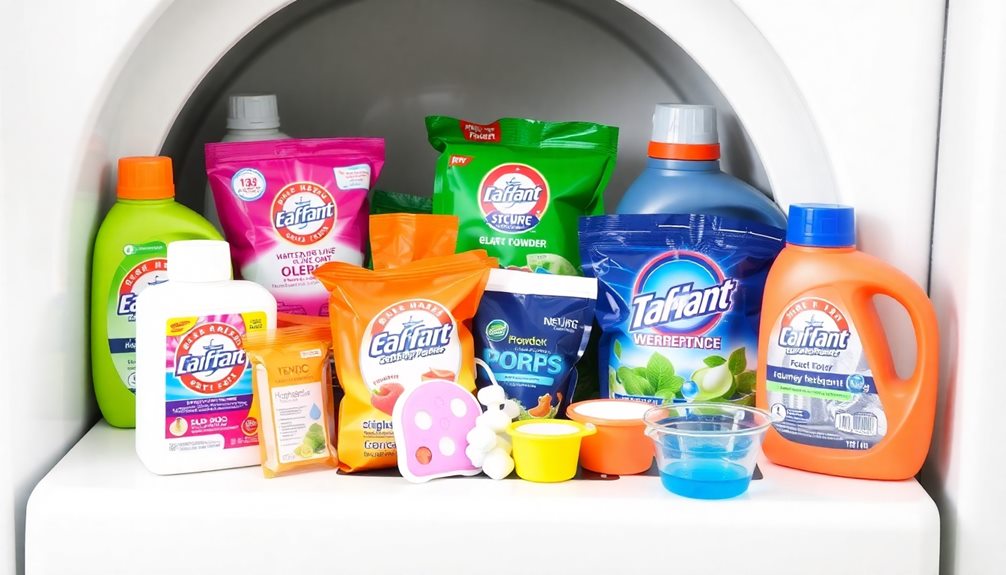
When it comes to selecting a laundry detergent, you've got several types to choose from, each with its own advantages.
Liquid detergent is popular for its effectiveness in removing grease and stains, making it easy to use, though it can get a bit messy during application.
On the other hand, powder detergent is a cost-effective option, especially suited for washing with warm water, which helps it dissolve properly.
If you're looking for convenience, pods or tablets might be your go-to. These pre-measured options simplify your laundry routine, but be cautious as their appearance can be dangerous for children and pets.
If you own a high-efficiency washing machine, consider using HE detergents. These are specifically formulated for your machine, offering a more concentrated formula, though they may come at a higher price.
Lastly, laundry soaps provide a natural alternative, often used in DIY detergent recipes.
When determining the amount of laundry soap to use, consider the type of detergent that best suits your needs. Choosing the right one can make a significant difference in the cleanliness of your clothes.
Factors Influencing Detergent Use
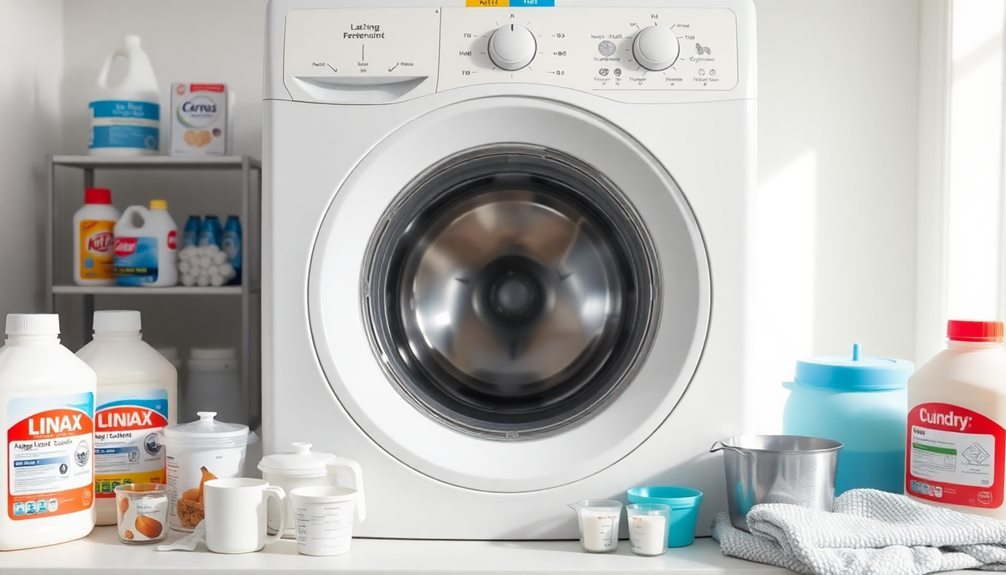
Several factors influence how much detergent you should use in your washing machine.
First, consider your load size. Small loads typically require less detergent, while larger or heavily soiled loads call for an increased detergent amount to guarantee effective cleaning.
Next, think about your water type. If you have hard water, you'll need more detergent than if you're using soft water, as hard water affects detergent effectiveness.
Fabric type also plays an important role. Delicate fabrics may need milder detergents, while heavily soiled items like work clothes might require stronger cleaning agents.
Additionally, the design of your washing machine matters. Front loaders are generally more efficient and use less water, so they require less detergent compared to top loaders.
Signs of Detergent Misuse
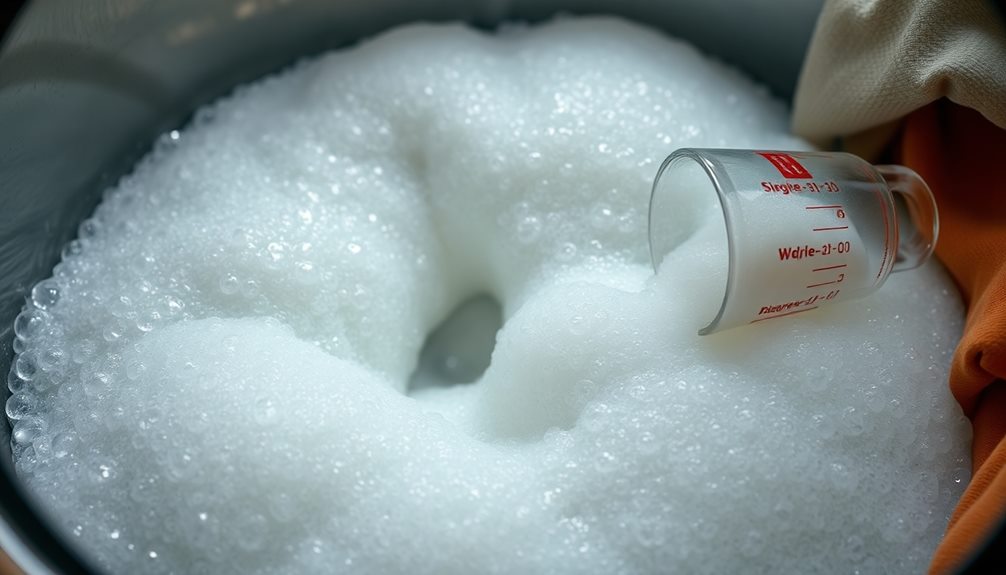
Misusing detergent can lead to a range of frustrating issues with your laundry. If your clothes feel stiff, sticky, or scratchy after washing, you're likely overusing detergent. This not only damages fabrics but can also cause fading.
On the other hand, if your clothes feel dirty or greasy and have a persistent unpleasant odor, it may indicate you're using an insufficient amount of detergent.
Look out for soap residue or clumping on your freshly washed clothes; this is a clear sign of excessive detergent application. Not only does this leave your garments looking unclean, but it can also lead to buildup in your washing machine.
If you notice a slimy washer basin or foul odors emanating from the machine, it's often due to soap residue buildup from using too much detergent.
Additionally, keep an eye out for dark spots or rust on your clothing, as these may suggest mold growth in the rubber boot of the washer, which thrives in environments created by excessive detergent.
Being mindful of these signs can help you maintain cleaner clothes and a well-functioning washing machine.
Costs of Overusing Detergent
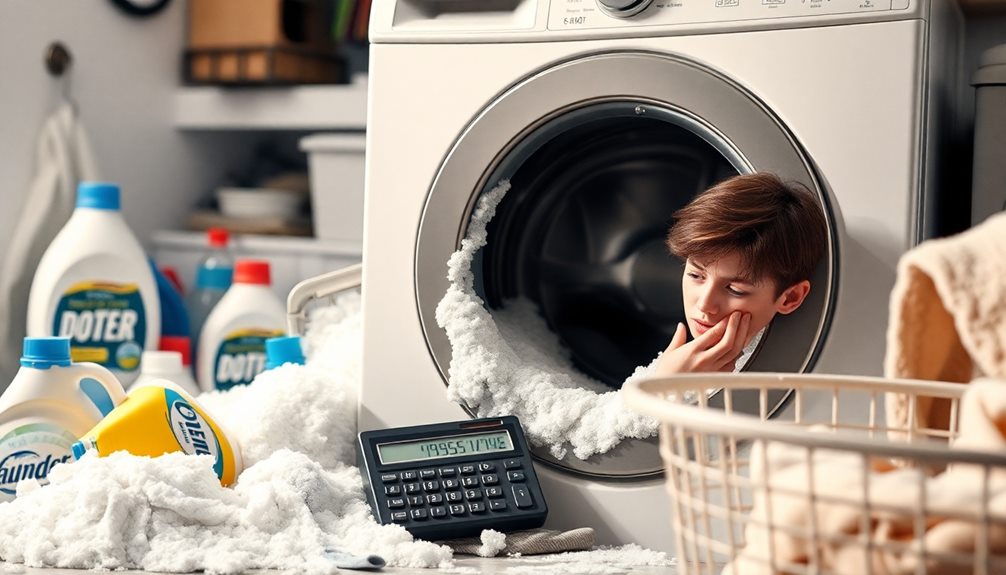
Using too much detergent can really add up, costing you more money without improving your laundry results.
It can also lead to buildup in your washing machine, increasing the risk of damage and potential repairs.
Increased Detergent Expenses
Overusing detergent can quickly lead to increased expenses that strain your household budget. When you use an excessive amount of detergent, you're not just throwing money down the drain; you're also increasing your detergent expenses with every wash.
This excess detergent creates soap residue buildup, which may require additional rinse cycles, further driving up your water and energy costs.
Moreover, using the correct amount of detergent can save you up to 30% on these expenses over time. Frequent purchases due to waste can considerably cut into your finances.
Additionally, the overuse of detergent can cause more wear and tear on your fabrics, leading to quicker replacements of clothing items, which adds to your overall household costs.
Machine Damage Risks
Excess detergent not only affects your wallet but can also lead to significant damage to your washing machine. Overusing detergent creates soap residue buildup, which can result in foul odors and a perfect environment for mold and mildew. This residue not only clogs components but can also lead to costly repairs or even a premature replacement of your appliance.
Here's a quick breakdown of the risks associated with excessive detergent use:
| Risk | Impact | Result |
|---|---|---|
| Soap Residue Buildup | Foul odors, mold, and mildew | Unpleasant washing experience |
| Clogged Components | Costly repairs, appliance replacement | Increased expenses |
| Suds Overflow | Damage to water-level pressure switch | Washer fails to drain/operate |
| Fabric Wear | Stiffness, fading, fraying of clothes | Reduced clothing lifespan |
Effective Laundry Practices

When doing laundry, measuring detergent accurately is key to getting the best results.
You should also adjust the amount based on the load size—smaller loads need less detergent, while larger ones may require the maximum recommended amount.
This simple practice not only boosts cleaning efficiency but also helps keep your washing machine in good shape.
Measuring Detergent Accurately
Measuring detergent accurately is essential for achieving the best results in your laundry routine. Using the right amount of detergent per load can make a significant difference in cleaning effectiveness.
For high-efficiency machines, stick to 1 to 2 tablespoons for regular loads, while traditional machines typically require about 1 ounce. It's vital to use a measuring cup or spoon, as detergent caps may suggest too much detergent, leading to residue buildup and potential machine issues.
When determining the amount, consider the soil level and load size. Smaller loads often need less than 1 tablespoon, while heavily soiled loads might require up to 3 tablespoons.
Water hardness also plays a role; for soft water, use 1 tablespoon, and for hard water, increase that to 2 tablespoons.
Regularly check your washing machine for signs of detergent overuse, like excessive suds or unpleasant odors. If you notice these issues, it's time to adjust and use less detergent for better performance and longevity of your appliance.
Adjusting for Load Size
Adjusting the amount of detergent based on load size is vital for achieving ideal cleaning results in your laundry. Using the right amount of laundry detergent can make a significant difference, especially when you consider the size of your load.
For small loads, you'll need less than 1 tablespoon of detergent, while medium loads require about 1 tablespoon. Full loads should use around 1 to 2 tablespoons, especially for HE machines.
When determining how much detergent to use, keep these points in mind:
- Heavily soiled clothes might need up to 3 tablespoons.
- Lightly soiled items can often be cleaned effectively with less than 1 tablespoon.
- Hard water may require increasing detergent amounts for maximum cleaning.
- Pre-measured pods can be misleading and may contain too much detergent.
It's important to adjust detergent amounts based on both load size and soil level.
Regularly measuring detergent with a cup instead of relying on cap measurements helps avoid excess that can harm both your clothes and washing machine. By fine-tuning your detergent use, you'll enhance the cleaning power of your standard laundry routine.
How to Load a Washing Machine
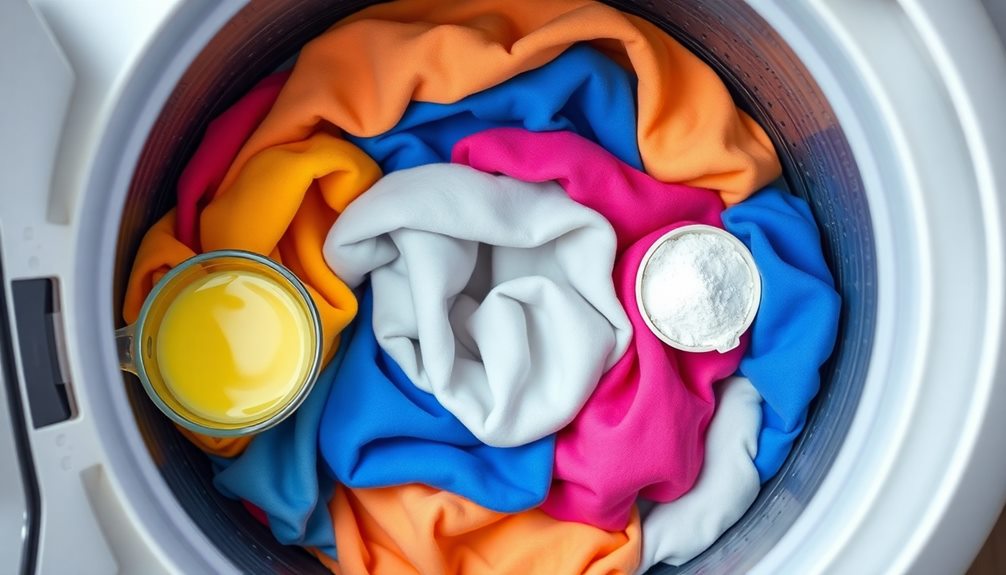
Loading your washing machine properly is essential for achieving the best cleaning results. To start, fill the drum no more than 75% full to allow the water and detergent to circulate effectively. If you pack your load too tightly, it can hinder the cleaning process and lead to poor results.
Distributing clothes evenly around the drum helps maintain balance during the wash cycle, reducing strain on your washer.
Before loading your laundry, it's a good idea to add how much laundry detergent you'll need. Always measure the right amount, especially if you're using liquid detergent. Using the automatic dispenser, if available, guarantees that the detergent is released at the right time during the wash cycle.
Regularly check for any signs of soap buildup or residue in your washer; this can affect performance over time.
Advanced Washing Machine Technologies

Modern washing machines have revolutionized laundry day with their advanced technologies, designed to meet the needs of busy households. These machines offer features that enhance your laundry experience, making it easier and more efficient than ever.
- Imagine eliminating 95% of pet dander with the Allergiene™ Cycle.
- Picture washing your clothes in under 30 minutes with TurboWash™ 360° Technology.
- Think about the energy savings from ColdWash™ Technology while keeping your fabrics intact.
- Envision managing your washing cycles remotely with smart technology.
With advanced washing machines, you can handle larger laundry loads without sacrificing performance. These machines optimize detergent per load, guaranteeing you use just the right amount while maintaining energy efficiency.
You'll appreciate the flexibility of choosing washing cycles tailored to your needs, whether you're tackling a quick wash or a more intensive clean. Plus, the convenience of smart technology means you can monitor your laundry from anywhere, giving you control over your busy schedule.
All these innovations guarantee that laundry day becomes less of a chore and more of a breeze, allowing you to focus on what truly matters.
Benefits of Efficient Washers

When it comes to doing laundry, efficient washers truly make a difference. They enhance your cleaning performance while using less water and energy compared to traditional machines. Many modern efficient models incorporate advanced technologies like TurboWash™ 360° and ColdWash™, which considerably reduce cycle times and energy consumption without sacrificing results.
Furthermore, these machines utilize energy-efficient technology that parallels the benefits seen in commercial heat pumps, leading to further reductions in utility bills.
Additionally, these efficient washers often come with larger capacities, allowing you to tackle bigger loads and save time on laundry days. You'll appreciate how quickly you can finish your chores, giving you more time for what really matters.
The integration of smart technology also adds convenience, enabling you to control and monitor your laundry remotely. This user-friendly experience means you can start or pause a cycle from anywhere, making laundry day less of a hassle.
Investing in energy-efficient washing machines can lead to substantial savings on your utility bills over time. You'll find that these machines aren't just eco-friendly; they're also a cost-effective choice for families.
Frequently Asked Questions
Do You Really Only Need 2 Tablespoons of Laundry Detergent?
You might think two tablespoons of laundry detergent is all you need, but it really depends on your load size and soil level. Always measure carefully to avoid stiff or sticky clothes from overuse.
How Much Laundry Soap Should You Use per Load?
You should use 1 to 2 tablespoons of laundry soap per load, depending on the size and soil level. Adjust based on your washer type, water hardness, and personal experience for the best results.
Can You Put Too Much Soap in a Washing Machine?
Think of your washing machine as a delicate garden; too much soap suffocates it. Yes, you can absolutely put too much soap in, leading to odors, mold growth, and potential malfunctions. Balance is key!
How to Tell if You Are Using Too Much Laundry Detergent?
You can tell if you're using too much laundry detergent by noticing slimy residue in the washer, stiff or sticky clothes, foul odors, or dark spots on fabrics. Regularly check for clumping detergent too.
Conclusion
In the grand tapestry of laundry care, using the right amount of soap is essential. By understanding detergent measurements and the factors influencing your choices, you'll not only achieve cleaner clothes but also save on costs. So, as you load your washing machine, remember that less can often be more—much like a well-crafted sonnet. Embrace efficient practices, and your garments will thank you, while your wallet remains as healthy as a lark.
